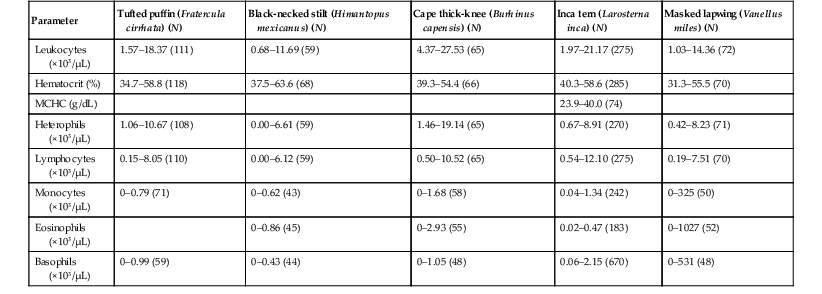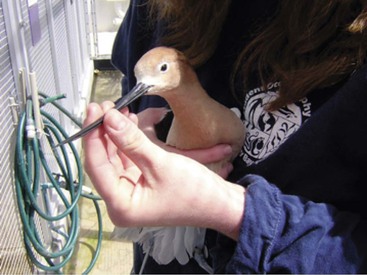Stephanie McCain Charadriiformes are a diverse group of birds with three suborders: Alcae, Charadrii, and Lari.6 The suborder Alcae includes the auks, with 22 species. The suborder Charadrii includes 203 species in 12 families, including avocets, ibisbills, jacanas, oystercatchers, plovers, sandpipers, snipes, stilts, thick-knees, and others. The suborder Lari contains 105 species and includes gulls, terns, skimmers, and skuas. Charadrii live, breed, and forage along the water’s edge, whereas Alcae and Lari are more aquatic. Charadrii are birds of the open, except the woodcock, which inhabits edges of wet, wooded areas, and solitary and spotted sandpipers may be found at heavily forested ponds and lakes, from sea level to high in the mountains. Shorebirds migrate over long distances; the red knot migrates from the Arctic region to Tierra del Fuego. Most shorebirds are gregarious, and mixed flocks of several species are frequently seen. A wide variation in appearance exists among the birds in this order. Alcids are generally small- to medium-sized birds with stocky bodies and short wings and tail. Charadrii tend to be long-legged and have a remarkable variety of bill shapes and sizes, from the long, down-curved bill of the curlew to the short, stubby plover’s bill. The Lari suborder comprises species ranging in size from small to large and slender- to heavy-bodied, long-winged birds. The skimmers have a unique bill structure, with a very narrow and long lower bill compared with the upper bill. The crop and the gizzard are often simple and reduced. Consideration must be given to land, water, and air space for these birds, and requirements will vary by species. Various substrates have been used successfully. Pools should be easy to clean and sized appropriately for the species and number of birds. Air quality may be important in preventing respiratory fungal infection,8,9 and exhibit design should consider open-air exhibits or those with proper ventilation and facility for purification. Quarantine and hospitalization should take place in appropriate-sized enclosures that allow for inclusion of a pool. A pool should be large enough for all birds housed in the room to enter the water all at once and should be located away from the entrance so that the birds feel safe in the pool when a staff member enters the room. A sandy shore or soft soil is recommended, as it allows normal feeding behavior. Adequate privacy and hiding places should be provided. Marine diets typically consist of fish or invertebrates. Captive diets may consist of these items or may also include commercial diets such as those prepared for birds of prey or flamingos. Following proper fish handling and storage guidelines is essential. Most shorebirds have a carnivorous nutritional feeding strategy referred to as faunivora. Faunivora is the digestive ability to separate digestible soft tissues from relatively indigestible components in prey items such as insects and invertebrates.14 The gizzard in these shorebirds is adaptable, with a large proventriculus for protein breakdown.14 Depending on the species of shorebird, the diet may consist of marine worms, fly larva, beetles, crustaceans, mollusks, small fish, seeds, and occasionally berries. Manual restraint is appropriate for most Charadriiformes species. If possible, the target individual should be restricted to a small area rather than caught in a large enclosure. The smaller the area and the fewer the birds in the area, the easier it is to catch the targeted bird. A net may be used to catch quick birds. A light towel or gloves may be helpful for restraint, particularly in alcids. If necessary, the pool should be drained or dropped. Alcids should be restrained by using one hand to secure the head and the other to secure the wings and by holding the bird against the body. In larger charadrii, the wings should be secured by holding the body tucked under one arm to help prevent causing any damage to the bird. A finger should be placed between the bird’s legs for better control and to ensure that the legs do not rub together. The head should be restrained with the other hand. Care should be taken with the beak, as it may cause injury to the handler; however, covering of the nares should be avoided. In some cases, a second person may be helpful to restrain the head. In the case of small charadrii, the bird may be held upright against the handler’s body with one hand to secure the wings and one hand to secure the beak (Figure 15-1). In even smaller species such as plovers, the restrainer may hold the bird in one hand with the back of the bird against the palm of the hand and the head between the index and middle fingers. The most common anesthetic agents used in Charadriiformes are isoflurane and sevoflurane. These may be administered via a face mask after manual restraint. Face masks may be fabricated from empty syringe cases with part of a disposable glove placed over the end to better fit long-beaked birds. Intubation should be performed when control of the airway is desired, as in prolonged procedures or if the bird is not ventilating well on its own. Breath holding may be seen in diving species. Anesthetic monitoring is similar to that in other birds. Use of a thermometer, electrocardiography, Doppler, pulse oximetry, capnography, and blood gas analysis may all be useful. Birds should be restrained during recovery and not allowed to recover in a crate, as they tend to flap as they recover and may injure themselves. The same restraint methods should be used, as described above, making sure that keel movement is not restricted. The most common surgical procedures include fracture repair, treatment of pododermatitis, and pinioning for flight restriction. The long legs of many Charadriiformes species are susceptible to trauma, especially during restraint. Treatment of pododermatitis is similar to that used in other avian species. The main methods of restricting flight include pinioning chicks, regular wing trimming, and the use of covered enclosures. Pinioning is more invasive, but regular clipping, which is the alternative, requires frequent restraint, which may result in injury. The pros and cons should be discussed at each institution. (Also see Chapter 65). Pharmacologic data are lacking in Charadriiformes, and dosages for most drugs are extrapolated from other avian species. Because of the susceptibility of alcids to aspergillosis, many institutions prophylactically treat these birds with antifungals (e.g., itraconazole) beginning a few days prior to shipment. Endoparasites may be treated with pyrantel, fenbendazole, or ivermectin, as appropriate. Capillaria is a relatively common parasitic disease of Charadriiformes and may be difficult to get rid of. Infestation with ectoparasites may be treated with ivermectin. Physical examination is easily completed during manual restraint. Blood samples may be collected under manual restraint or general anesthesia. The jugular vein, ulnar vein, and metatarsal vein are all commonly used sites. Care must be taken to provide adequate hemostasis when using the ulnar or metatarsal vein, as these sites are prone to hemorrhage for a longer period compared with the jugular vein. A wrap may be applied to the leg for a brief period, if necessary. Reference values for hematologic and biochemical parameters of selected species are listed in Tables 15-1 and 15-2.12 TABLE 15-1 Reference Intervals for Hematological Parameters of Selected Species.12 MCH, Mean corpuscular hemoglobin; MCHC, mean corpuscular hemoglobin concentration; MCV, mean corpuscular volume. From Teare JA, ed: 2013, “Tuffed Puffin; Black-necked Stilt; Cape Thick Knee; Inca Tern; Masked Lapwig;_No_selection_by_gender__All_ages_combined_Conventional American Units and Values__2013_CD.html” in ISIS Physiological Reference Intervals for Captive Wildlife: A CD-ROM Resource., International Species Information System, Bloomington, MN.
Charadriiformes
General Biology
Unique Anatomy
Special Housing Requirements
Feeding
Restraint and Handling
Surgery
Other Pharmaceuticals
Physical Examination and Diagnostics
Parameter
Tufted puffin (Fratercula cirrhata) (N)
Black-necked stilt (Himantopus mexicanus) (N)
Cape thick-knee (Burhinus capensis) (N)
Inca tern (Larosterna inca) (N)
Masked lapwing (Vanellus miles) (N)
Leukocytes (×103/µL)
1.57–18.37 (111)
0.68–11.69 (59)
4.37–27.53 (65)
1.97–21.17 (275)
1.03–14.36 (72)
Hematocrit (%)
34.7–58.8 (118)
37.5–63.6 (68)
39.3–54.4 (66)
40.3–58.6 (285)
31.3–55.5 (70)
MCHC (g/dL)
23.9–40.0 (74)
Heterophils (×103/µL)
1.06–10.67 (108)
0.00–6.61 (59)
1.46–19.14 (65)
0.67–8.91 (270)
0.42–8.23 (71)
Lymphocytes (×103/µL)
0.15–8.05 (110)
0.00–6.12 (59)
0.50–10.52 (65)
0.54–12.10 (275)
0.19–7.51 (70)
Monocytes (×103/µL)
0–0.79 (71)
0–0.62 (43)
0–1.68 (58)
0.04–1.34 (242)
0–325 (50)
Eosinophils (×103/µL)
0–0.86 (45)
0–2.93 (55)
0.02–0.47 (183)
0–1027 (52)
Basophils (×103/µL)
0–0.99 (59)
0–0.43 (44)
0–1.05 (48)
0.06–2.15 (670)
0–531 (48)

![]()
Stay updated, free articles. Join our Telegram channel

Full access? Get Clinical Tree


Charadriiformes
Chapter 15

